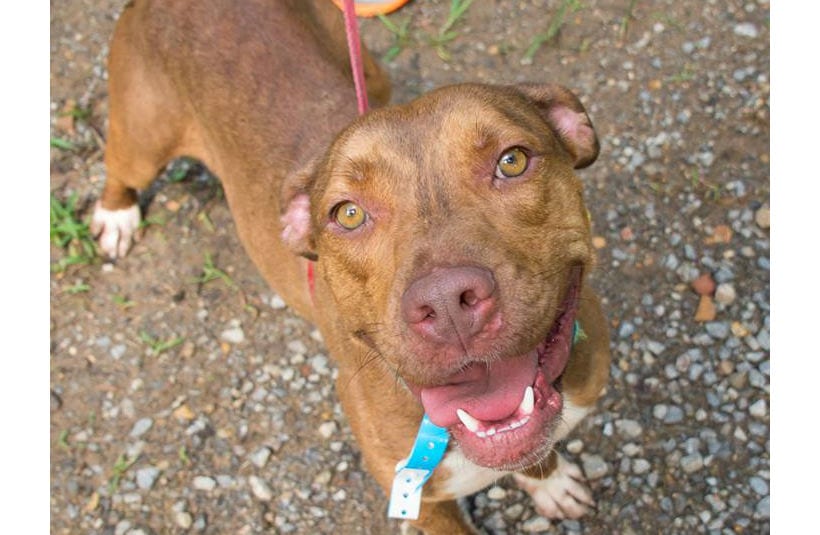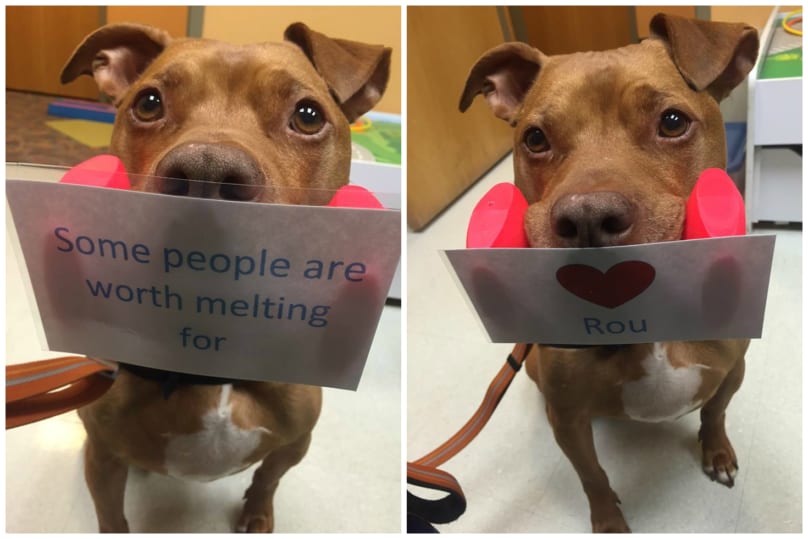PETA runs a shelter at its headquarters in Norfolk, Virginia, where most animals who come in don’t make it out alive.
The figures have been released for how many animals died there in 2015. They prove — once again — that it’s past time for that shelter’s practices to change, or for the shelter to shut down altogether.
Well, at least the killing’s gone down a little in the last year.
According to a statement the nonprofit put out on Friday, PETA euthanized 1,502 dogs, cats and other animals in 2015 at the nonprofit’s only animal shelter.
PETA’s shelter took in 2,063 animals in total in 2015, according to another statement. That means 72.8 percent of the animals who came into the shelter were euthanized.
(We don’t have the breakdown yet for how many of these are cats, dogs, or others.)
[bp_related_article]
That’s less than in 2014. According to self-reported figures filed with Virginia’s Department of Agriculture and Consumer Services, 3,017 came into the shelter, of which 2,455 animals were killed — a kill rate of 81.3 percent.
This all may come as a surprise to you if you are someone who isn’t already familiar with PETA’s controversial shelter. It certainly came as a surprise to me when I first began reporting on — and trying to make sense of — the nonprofit’s strikingly high kill rate a couple of years ago.
What I’ve come to understand, after all this time, is that PETA’s approach to companion animals, to pets, doesn’t actually make sense — unless you hold the perverse belief, which I do not, that many animals should die to be saved.
Take that PETA — People for the Ethical Treatment of Animals!– is part of a terrible anti-Pit Bull coalition. PETA also encourages the killing of feral cats.
They claim that they’d like to terminate these animals — and the shelter pets — for their own good. This world is too dangerous, too hostile, for these animals, is how PETA puts it — given that they may be abused, or become sick, and then live or die in ways that are terrible to contemplate.
As I’ve written before, their logic has no natural end. Poachers would like to hunt down elephants — should we preemptively kill these magnificent creatures in order to prevent the poachers from taking them?
And what about human babies, who may also be victims of abuse? I don’t think anyone, even PETA, likes where this logic takes us.
Because a lot of people still think that PETA has moral authority when it comes to animals, PETA has gotten away with its own killing.
What makes PETA more dangerous is that others are encouraged to follow in its footsteps.
Just last year, a policymaker in Washington, D.C., told me that it was OK for the nation’s capital to consider rounding up and killing feral cats, because even PETA supported that plan.
The same thing is happening now in Georgia, where one community is debating whether it’s better to vaccinate and feed feral cats (called trap, neuter, return, or TNR), or bring them to a shelter and kill them, which is PETA’s preferred approach.
“Fort Oglethorpe has chosen as its authority PETA (People for the Ethical Treatment of Animals), according to city manager Ron Goulart,” according to Northwest Georgia News:
PETA opposes TNR-feed and advocates trapping all feral cats, finding homes for them when possible and euthanizing them when not, said PETA’s animal care and control specialist Teresa Chagrin. Chagrin acknowledged the difficulty of adopting out a feral cat but said that euthanization is more humane for the cats, who might die terrible, diseased deaths in the wild, and for the animals cats hunt and cause to die painfully.
Before I was a journalist, I was a lawyer. Long before then, I was a philosophy major. I also taught LSAT. In other words, I like a good logic puzzle.
I keep writing about PETA because I keep trying to solve this puzzle. How can a group that is supposed to make the world a kinder place for animals, think that killing so many of them is the way to make that happen?
And how can we stop so many of these animals from being killed?
Let’s put the shelter itself in context: Even having gone down considerably this last year, PETA’s kill rate is still much higher than the Virginia state average.
Statewide in 2014, 230,654 animals came into Virginia shelters and rescue groups, of which 52,850 were euthanized — a kill rate of 22.9 percent.
Counting just city and county facilities — not private shelters and rescue groups — 124,247 animals came into Virginia’s shelters, of which 42,146 were euthanized, representing a kill rate of 33.9 percent. (Not all shelters and rescue groups have reported their 2015 figures yet. This piece will be updated once that information is available.)
Hello, I’m Carl! I was left behind when my former guardian moved away from their trailer park 🙁 But #PETA rescued me …
Posted by PETA (People for the Ethical Treatment of Animals) on Tuesday, January 5, 2016
PETA defends — even justifies — its kill rate by claiming that it isn’t running a “traditional” animal shelter, but an open-admission “shelter of last resort” that takes in any animal brought to it.
“PETA performs the heartbreaking task of euthanizing animals who are unwanted for one reason or another: because they are aggressive, sick, hurt, elderly, or at death’s door and because no good homes exist for them,” the group writes on their website.
This language is repeated in Friday’s statement. As one of its 2015 achievements, the group lists “euthanizing 1,502 elderly, feral, sick, dying, aggressive, and otherwise unadoptable animals free of charge.”
PETA did not respond to my request for comment on whether its 2015 figures represent any change in philosophy or practice. I will update this piece with any new information.
And to be fair, I do recognize some good work that PETA has done. The group provides thousands of free and low-cost spay and neuter surgeries. It gives out pet food and other supplies to folks who might not otherwise be able to take care of their pets. These are valuable services.
However, these good deeds do not make up for the harm that PETA causes.
This is an organization that purports to do right by animals — by removing animals from the world?
Here’s a PETA blog post called “Animal Rights Uncompromised: Euthanasia“:
As difficult as it may be for us to accept, euthanasia (when carried out by veterinarians or trained animal shelter professionals with a painless intravenous injection of sodium pentobarbital) is often the most compassionate and dignified way for unwanted animals to leave a world that has no place for them.
I have been there when my own pets were euthanized. It was awful, and right.
It is likely that sometimes, euthanasia is the most compassionate choice at the PETA shelter, too. But probably not 1,502 times a year, in one shelter that’s only taken in 2,063 animals. Especially not when that shelter has the backing of a group with $43 million in donations. After all, this is not a high-volume shelter working with limited resources.
PETA often rails against the idea that shelter animals should be kept alive in cages, for the sake of life alone. The group claims that so-called “no kill” shelters warehouse animals who have no real prospects of being adopted, and may then live a life of suffering when they would be better off dead.
Presumably, this philosophy guides many of their own killings — even though they don’t come out and say it.
But how would PETA even know if these 1,502 animals are unwanted, or had no legitimate adoption prospects? Here’s a little test for you — try to search online to find the PETA shelter’s operating hours. When can you stop by there to visit with, maybe even adopt, a pet? Or see if you can find the listings online?
You likely can’t find either.
While PETA’s Facebook and Twitter accounts exhort followers to adopt, never to buy from a breeder, they put seemingly no resources into giving their own animals the opportunity to be adopted. There’s an occasional Facebook post for a dog or a cat who was lucky enough not to die, and may now be adopted. But these animals aren’t even listed on Petfinder or any of the other major online adoption websites.
Every time dogs are bought from a pet store or breeder, homes are taken from shelter dogs who need it. #AdoptDontBuy pic.twitter.com/SZbU4i3Ce0
— PETA (@peta) February 25, 2016
Indeed let’s finally look at another stark PETA figure from 2015 that went down from the year before: the number of their shelter animals that got adopted. In 2014, per the group’s self-reported figures, 162 animals met that lucky end.
Last year, that number was lower still — just 94 of PETA’s shelter pets were adopted. In other words, in 2015, PETA’s shelter had an adoption rate of 4.5 percent — down from 5.3 percent during the previous year.
We don’t know what Virginia’s 2015 statewide adoption rate is yet. But compare that to the statewide figures for 2014: 39.6 percent of the animals that came into all Virginia shelters and rescue were adopted into homes.
Previously, the group has refused to explain to me the process by which it determines which animals will live and which will die; what medical and behavioral examinations are undertaken, to see how aggressive, sick, or hurt these animals are. (This information is readily provided by other shelters).
It’s extremely problematic, since any organization that asks to be trusted with the power of the needle should be willing to explain how it decides when to use that power. This is especially true when the group wielding the needle purports to have moral authority when it comes to animals — when some policymakers still look to this group as offering real guidance as to what is good for animals.
Perhaps worse is that, even if the animals were as sick or old or badly-behaved as PETA claims, death should not be a foregone conclusion. As Tabitha Frizzell Treloar, director of advancement for the Society for the Prevention of Cruelty to Animals in Richmond, Virginia, put it to me:
“For an avowed animal rights organization to attest that the value of an animal’s life is determined by usefulness to humans is contrary to both logic and compassion. Their use of ‘feral,’ ‘unadoptable’ and ‘unwanted’ as reasons for killing an animal are deeply troubling.”
Moreover, there are lots of organizations — including the Richmond SPCA — finding homes for exactly these so-called “unadoptable” animals.
You need look no further than the Mr. Mo Project to see a stellar example of how it’s extremely possible to take the “unwanted” animals and find them loving homes. Its founders — Chris and Mariesa Hughes — take elderly and sick dogs from high-kill shelters around the country and place them in foster homes for the rest of their lives.
There, the dogs are loved and cared for, with all their medical and living expenses paid for with donations. Chris and Mariesa have even sold their own belongings to help cover these animals’ bills.
In the last year-and-a-half, the Mr. Mo Project has saved about 100 senior dogs for about $150,000. Just imagine what a group like The Mr. Mo Project could do with PETA’s $43 million in donations.
Meet Chief! This gentle dog was stuck outside 24/7 & kept getting infections. Since #PETA rescued him, Chief has…
Posted by PETA (People for the Ethical Treatment of Animals) on Tuesday, February 23, 2016
Lately, it seems PETA’s policies around this are finally moving people to action. Last year, Virginia lawmakers even passed a bill basically telling PETA to knock it off with the killing. That bill has not yet been implemented — and PETA has vociferously fought its implementation.
In light of this, I think that the public should tell PETA that its shelter must do better, or its shelter must shut down. Tell them on Facebook or Twitter or by donating to any number of other organizations that are more transparent, that don’t routinely kill — or ask others to kill — society’s most vulnerable creatures. (Feel free to email me, if you want some recommendations.)
PETA’s standard line about euthanasia is that there are “fates worse than death.”
This seems so obvious it shouldn’t even have to be said. But what PETA is failing to recognize here is another very crucial truth: There are also fates much better.
Featured image via angela n./Flickr






